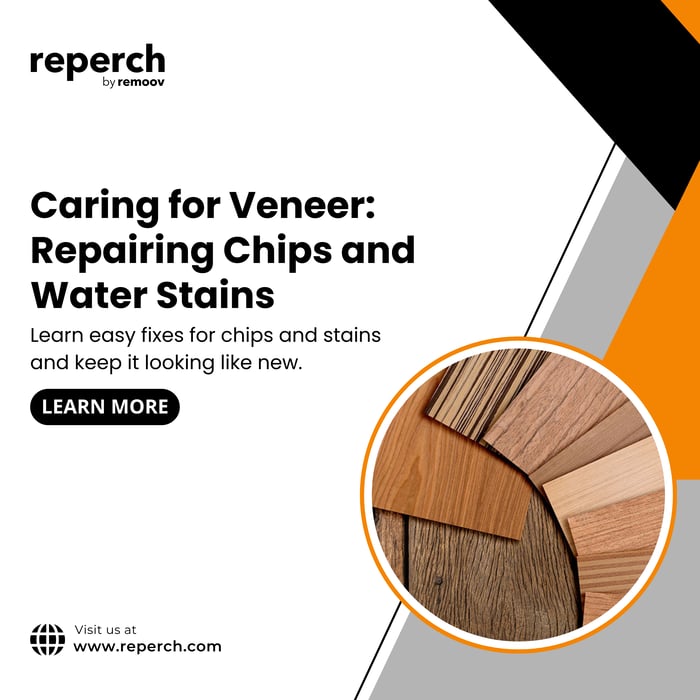Veneer furniture offers the best of both worlds: the beauty of real wood at a fraction of the price and weight. But just like solid wood, it can suffer from everyday wear and tear. Over time, chips and water stains are common issues that can take away from the polished look you originally loved. The good news is that most veneer damage is fixable with the right tools, techniques, and a little patience.
In this guide, we’ll walk you through how to repair chips and water stains on veneer furniture, when to DIY versus call in a pro, and tips to prevent future damage.
What Is Veneer Furniture?
Before jumping into repairs, it helps to understand what veneer actually is. Veneer furniture is made by attaching thin slices of real wood (the veneer) to a core made of less expensive materials such as particleboard, plywood, or MDF. The result is furniture that looks like solid wood but is more affordable and often lighter.
Because the wood layer is so thin, usually less than 1/8 of an inch, it’s more prone to damage from moisture, impact, or heavy use. This makes timely and proper repair essential to preserving the look and integrity of your furniture.
Common Types of Veneer Damage
The most frequent issues with veneer furniture include:
Chipped veneer: This occurs when part of the thin wood layer peels off, leaving a gap.
Water stains: Caused by spills, steam, or condensation from hot or cold items.
Bubbling or lifting: Moisture seeps under the veneer, causing it to warp.
Scratches or dents: From keys, jewelry, or everyday objects.
This blog focuses specifically on repairing chips and water stains, two of the most visible and frustrating problems.
How to Repair Chipped Veneer
A chip in the veneer might look permanent, but with a few supplies and some care, you can restore the surface almost seamlessly.
Step 1: Clean the Surface
Start by cleaning the damaged area with a soft cloth and mild dish soap diluted in water. Remove any dust, grime, or oil that might prevent glue or filler from bonding properly.
Let the area dry completely before you begin the repair.
Step 2: Assess the Damage
Is the veneer completely missing in the chipped area? Or is it partially lifted but still attached? Your approach will depend on the answer.
If the piece is still attached: You may be able to glue it back into place.
If it’s missing: You’ll need to patch the area using filler or a new piece of veneer.
Step 3: Reattach Loose Veneer
If the chipped section is still hanging on:
Apply a small amount of wood glue under the loose section.
Press it down and clamp it or place a heavy object on top.
Wipe off excess glue before it dries.
Let it cure for 12 to 24 hours.
Step 4: Patch With Wood Filler
If a piece is missing entirely:
Fill the chipped area with wood filler or wood putty using a small putty knife.
Smooth the filler so it’s flush with the surface.
Let it dry fully according to package instructions.
Sand the area lightly using fine-grit sandpaper (around 220 grit) until smooth.
Step 5: Touch Up the Color
Use a wood stain pen or touch-up marker that matches your veneer color. Apply it carefully over the repaired area to blend it with the surrounding finish.
For more visible damage or a smoother blend, you can apply a wood finish or polyurethane sealant over the entire surface after the repair.
How to Remove Water Stains From Veneer
Water stains on veneer can range from light, cloudy marks to deep, dark discoloration. The repair method depends on the severity of the stain and how long it's been there.
Step 1: Identify the Type of Stain
White or cloudy stains are usually from moisture trapped in the finish.
Dark stains indicate water has penetrated through the finish into the wood or substrate.
Step 2: Try Heat for White Stains
One of the simplest ways to remove white rings or cloudy marks is with gentle heat.
Lay a clean cotton cloth over the stain.
Use an iron on low heat, no steam, and press it gently on the cloth for a few seconds.
Lift the cloth and check. Repeat until the stain lightens.
The heat helps evaporate the trapped moisture in the finish.
Step 3: Use Baking Soda or Toothpaste
For stubborn white stains:
Mix baking soda with a few drops of water to form a paste.
Gently rub the paste onto the stain using a soft cloth in a circular motion.
Wipe clean and dry.
You can also try non-gel white toothpaste instead of baking soda for a similar effect.
Always test in an inconspicuous area first to avoid damaging the finish.
Step 4: Sand and Refinish for Dark Stains
Dark water stains are more difficult and often require sanding and refinishing:
Lightly sand the affected area with fine-grit sandpaper.
Use a wood bleach (like oxalic acid) if the stain persists.
Once the area is clean and dry, re-stain and seal to match the rest of the veneer.
If the stain is extensive or the veneer is warped, you may need to replace the veneer patch entirely.
When to Replace vs. Repair Veneer
While many chips and stains are manageable with DIY fixes, there are times when veneer replacement is the better option:
The damage is larger than a few inches.
The veneer is lifting or bubbling across a wide area.
The substrate underneath is damaged or swollen from water.
In those cases, removing the damaged veneer and applying a new piece might be the most durable and aesthetic solution. This typically requires more advanced tools, precision cutting, and staining skills.
Preventing Future Damage to Veneer Furniture
The best way to protect your veneer furniture is through regular care and a few protective habits:
Use coasters and placemats to prevent moisture rings and heat damage.
Wipe spills immediately to avoid water absorption.
Avoid harsh cleaners or polishes that can weaken the finish.
Control humidity in your home to prevent warping or lifting.
Lift items instead of dragging them across surfaces to avoid scratches or chips.
Veneer furniture may be delicate, but with the right care, it can look beautiful for decades.
Final Thoughts
Chipped veneer or water stains don’t have to mean the end of your furniture’s life. With a few household tools and some patience, most common issues can be repaired without calling in a professional. Whether you picked up a beautiful secondhand sideboard or want to keep a vintage dresser looking its best, these repair techniques can help bring your piece back to life.
And if you're still hunting for the perfect used furniture in the Bay Area, Reperch is here to help. We connect you to high-quality secondhand furniture that’s worth restoring, reusing, and loving for years to come.








